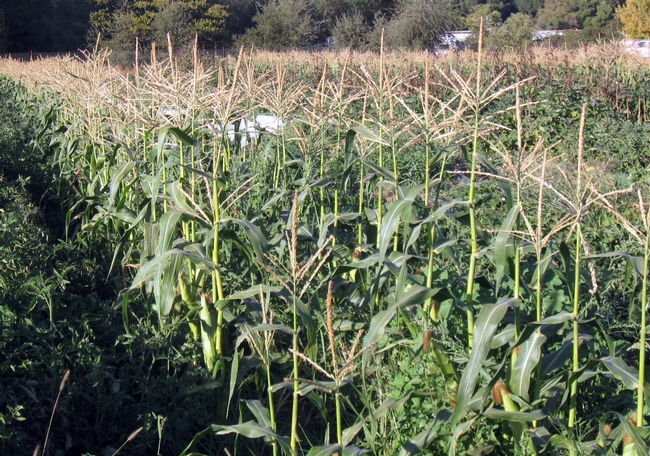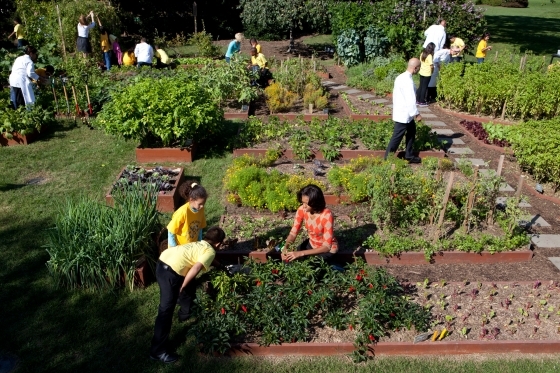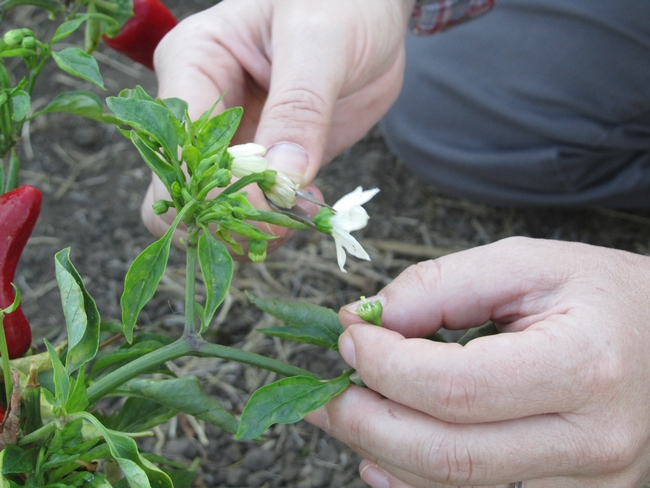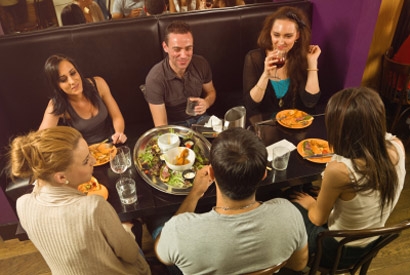Main story
Corn smut for dinner tonight...yum!
I often look at foods and wonder, “Who’s idea was it to eat this?” Some foods just don’t look like they should be food, including huitlacoche.
Huitlacoche is corn smut — a fungus that often infects sweet corn during times of drought. It enters the plant through the ovaries, and replaces the corn kernels with large tumor-like spores that look like really ugly mushrooms. Farmers in the U.S. have spent millions of dollars trying to eradicate the infection. The UC Davis Student Farm has a bad case of corn smut this year, and it’s threatening to ruin their entire crop.
But it may not be such a bad thing. Often known as the Mexican truffle, huitlacoche is considered a delicacy in Mexico. In fact, the Aztecs used to purposely scratch their corn plant with a knife to encourage the growth of huitlacoche.
According to this article in the Huffington Post, huitlacoche may actually be more nutritious than the corn it infected. It’s full of protein, minerals, and other nutritious compounds that don’t always exist in the corn itself. It’s also more valuable than the corn itself — in a study conducted by University of Wisconsin, an ear of huitlacoche sold for approximately $1.20 and cost about 41 cents to produce. An ear of corn without the infection cost less than 10 cents to produce, but sold for only a few cents more.
Although it sells for approximately $20 per pound in Napa Valley, few American growers have converted to growing the fungus. Most American growers lack the resources needed for inoculation, and huitlacoche is highly perishable; however, demand is slowly increasing and several American growers have started growing the specialized crop.
Huitlacoche is typically found in tacos, quesadillas, tamales, and other traditional Mexican cuisine. In the U.S., it’s mostly found canned in Mexican grocery stores, and can occasionally be found in high-end restaurants or traditional Mexican restaurants. Want to give it a try? For suggestions of restaurants that serve the delicacy in the San Francisco Bay Area, read this blog at chowhound.com. Or if you’re really brave and want to cook it yourself, try including it as a side dish or making huitlacoche soup.
I was out at the UC Davis Student Farm this weekend looking for huitlacoche, and sure enough, about one in every 10 ears of corn had it. Though it could be profitable, the student farm has no intention of selling it this time around.
“We just don’t have the resources to harvest it, and we don’t have the market here to make it profitable” said Edwina King, the Market Garden Coordinator at the UCD Student Farm.
But that won’t stop some locals from getting excited about the crop. Jessica Myles, a UC Davis graduate student who helped me identify the fungus at the student farm, harvested some herself.
“I’m going to go home and cook it up and freeze it, I’m so excited!”
She’s promised to make me huitlacoche tamales. As curious as I am about trying it, I may have to close my eyes while I eat it. Stay tuned.
UC Cooperative Extension leader to 'Tweet' from White House garden on Friday
California will be well represented on Friday, Oct. 19, when Michelle Obama's kitchen garden – a model vegetable garden on the south lawn of the White House – is the site of a national "Tweetup.” Rose Hayden-Smith, UC Agriculture and Natural Resources sustainable food systems initiative leader, will be part of the White House Social Fall Garden Tour.
Follow the event in real time from 5 a.m. to 12 noon Pacific Time on Twitter using the tag #whgarden.
White House Social is a series of in-person meetings of people who engage with the White House through social media, including Twitter, Facebook and Google+. Hayden-Smith has followed Barack Obama, Michelle Obama and the White House on Twitter since Obama's election in 2008. She won the invitation after entering a contest that asked contestants to describe in 140 characters why they wanted to visit the White House garden.
"I'm really excited to be part of this,” said Hayden-Smith, who is also a UC Cooperative Extension advisor in Ventura County, specializing in 4-H youth, family and community development. "The fact that the Obamas are cultivating a food-producing garden on the grounds of the White House says really wonderful things about our country. The First Family is showing its concern about the health of Americans and reducing childhood obesity. That's something we at UC Cooperative Extension care a great deal about.”
Hayden-Smith Tweets as "Victory Grower” (@victorygrower) a persona she created to reflect her interest in a national revival of the Victory Garden movement, in which increasing food production was considered vital to bolstering national security by creating a more secure food supply.
"It's a different 'victory' now, but many of the goals are the same," Hayden-Smith said. "Gardens connect people with food and food production. Food is fundamental. It's what everyone shares in common. As we are entering a more challenging era of increased population and pressure on resources, it is vital for people to understand how to cultivate food.”
Hayden-Smith travels to Washington D.C. on Wednesday, Oct. 17. On Thursday, she and her colleague Rachel Surls (@rachelsurls), UCCE advisor in Los Angeles County, will tour urban garden projects in the nation's capital. They will be Tweeting about their tour on Thursday afternoon using the tag #urbanag.
Though not an official part of White House Social, Surls will have a brief tour of the White House Kitchen Garden on Friday. She will Tweet on Friday using the tag #whgarden.
Surls and Hayden-Smith are joining with UC Agriculture and Natural Resources to promote urban agriculture in California, an effort that is expected to generate multiple benefits. Gardening provides a way for people to be physically active, to improve food access, to increase fruit and vegetable consumption and to reconnect people with agriculture.
Following are background articles related to Victory Grower and urban agriculture efforts:
- Victory Gardens: A boon in hard times
- Summon us to service
- Kitchen table memories
- Urban Agriculture: A good model then, a good model now
- On the future of food
- UC helps you design your landscape and eat it, too
- Outlook: UC's land-grant mission fuels nation's growth, prosperity
- Setting agricultural science strategy in tumultuous economic times
Captivating capsicums: Igniting interest in plant breeding
Peppers in an array of colors, shapes, sizes and flavors grown at the UC Davis Student Farm are igniting interest in plant breeding and the astonishing botanical diversity of the Capsicum genus, to which all peppers belong.
“Fifty-two varieties is a wonderful candyland for me, but it’s just a few of the many varieties in the world,” said graduate student Ildi Carlisle-Cummins, who works on a partnership project between the Student Farm and researcher Allen Van Deynze.
Funded by the U.S. Department of Agriculture, the pepper project is meant to educate students and the general public about the importance of plant diversity and career opportunities in plant breading.
“Peppers make it easy because they leave such a strong impression,” said Carlisle-Cummins, who has been organizing field trips for students from second grade and up. “Students become fascinated with plant diversity and variety, and want to know more about molding and shaping it.”
While Carlisle-Cummins’ personal research is focused on sustainable food systems, she is delighted to explain cross pollination to show students how to develop new varieties of plants.
Plant breeding allows humans to select for certain desired traits, such as flavor, yield and pest resistance.
Agricultural has always been a dynamic, innovative industry, Carlisle-Cummins points out. Peppers originated in South America, in the region around modern day Bolivia. Over the centuries, a few species were taken by explorers all over the world. Farmers developed a kaleidoscopic array of subvarieties to suit their needs. Today, researchers are focused on developing new varieties to address new issues, like climate change.
“The world is changing,” Carlisle-Cummins said. “It’s pretty critical we have crops that can survive new places and climates and continue to feed us. It’s critical that we continue to inspire people to go into these fields of research so we have people who know how to work with plants, so they adapt along with a changing world.”
The chile pepper program continues throughout the year. Contact Ildi Carlisle-Cummins at icarlislecummins@ucdavis.edu to find out about upcoming events.
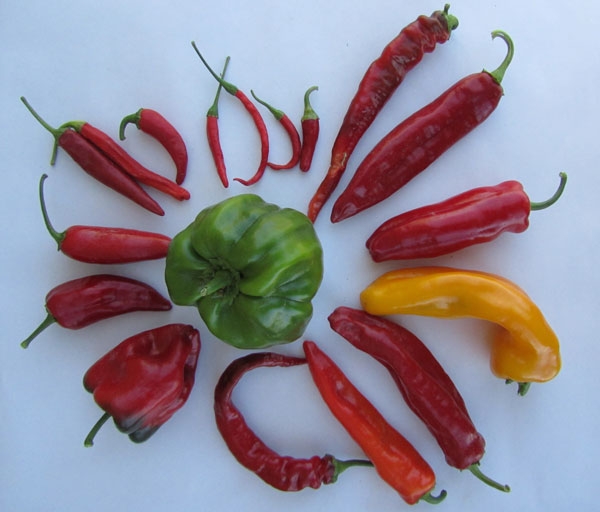
An array of peppers.
UC Davis voted America’s “coolest” school
After just experiencing my first Davis summer, I find it hard to describe anything in Davis as cool. But according to Sierra Magazine, UC Davis is just that. So much so, that the school was recently named the #1 Coolest School in the nation. Granted, they weren’t talking about the weather. Instead, they were referring to UC Davis’ environmental stewardship.
With all that UC Davis does to create and promote environmentally friendly programs and facilities, it’s no wonder the university just received this high honor. The campus is on track to reduce campus greenhouse gas emissions back to 1990 levels by 2020 and reduce campus electrical use by 60 percent by 2015.
UC Davis also provides sustainable forms of transportation to 85 percent of students and 46 percent of employees. As a fairly new Davis resident, I’m still constantly blown away by the number of bikes on campus, especially during the first week of school. Being from Long Beach, I always feel a pang of culture shock watching the Davis police handing out bike traffic violations instead of combating violent gang activity.
In 2011, UC Davis encouraged recycling, composting and reuse efforts that prevented 64 percent of campus waste from entering landfills. Sierra Magazine praised the university for its green purchasing, spending more than 20 percent of its $5.6 million food budget on local and organic products.
UC Davis also received international attention last fall, when it officially opened the doors to UC Davis West Village, the nation’s largest planned zero net energy community.
“At UC Davis, sustainability is one of our core values,” said UC Davis chancellor Linda P.B. Katehi. “I am very proud of the students, faculty and staff who have worked so hard to make this achievement possible and to invest in a more sustainable future for our campus.”
Other California schools that made the top 10 included Stanford University at number 3, and UC Irvine at number 9. California had the highest contingency of schools in the top 10 list.
Congratulations to UC Davis, for earning the title of Coolest School in the middle of this summer’s heat!
Watch this Sierra Club video highlighting UC Davis’ green achievements to learn more:
Yelp ratings give restaurants a boost
Every wonder whether those crowd-sourced reviews online actually make a difference in a business’s bottom line? For restaurants, the answer is an unequivocal yes, according to a new study by UC Berkeley economists. Researchers analyzed restaurant ratings on Yelp.com and found that, on a scale of 1 to 5 stars, a half-star rating increase translates into a 19 percent greater likelihood that an eatery’s seats will be full during peak dining times.
“This is the first study to link online consumer reviews with the popularity of restaurants,” said study lead author Michael Anderson, assistant professor in the Department of Agricultural and Resource Economics at UC Berkeley. “We show that social media sites and forums play an increasingly important role in how consumers judge the quality of goods and services.”
Anderson and study co-author Jeremy Magruder, also an assistant professor the Department of Agricultural and Resource Economics, analyzed 148,000 Yelp reviews for 328 restaurants in the San Francisco Bay Area. Their results, published this summer in the Economic Journal, did not take into account either price or service; they analyzed only the impact of positive Yelp reviews.
The study found that moving from 3 stars to 3.5 stars increases a restaurant’s chance of selling out during prime dining times from 13 percent to 34 percent, and that moving from 3.5 stars to 4 stars increases the chance of selling out during prime dining times by another 19 percentage points. These changes occur even though restaurant quality remains constant.
Not surprisingly, the economists found that crowd-sourced reviews have a bigger impact when there is a lack of alternative information available by which to judge a restaurant’s quality. They also found that restaurants rated in popular guidebooks or newspaper rankings did not see a statistically significant effect from the Yelp rankings.
“If a restaurant has a Michelin star or it appears in the San Francisco Chronicle’s list of Top 100 Restaurants in the Bay Area, the Yelp star becomes irrelevant,” said Magruder. “Those restaurants are relatively famous, and consumers already know them. For restaurants that were not on those established reviews, we actually saw a 27 percent greater likelihood in filled seats during peak dining times with a half-star rating increase on Yelp.”
Could these findings lead to potential manipulation of the ranking system for profit?
“We considered that possibility, and our study indicates that so far, such manipulation is under control,” said Anderson. “There are enough reviews available that it would be difficult to generate enough fake positive reviews to drown out the bad ones. There is also an element of self-policing since customers going to a restaurant on the basis of a good fake review only to be disappointed could submit a bad review. It could be hard for the business owner to sustain the false positives over time.”
The researchers are now looking to expand their analysis beyond eateries to sites such as Amazon.com, Tripadvisor.com and Netflix.com.


